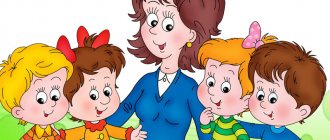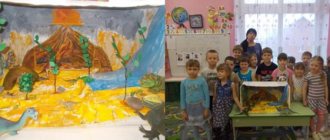Specifics of the project work of the kindergarten teaching staff
Project activity is an innovative method of working with children that has shown its high effectiveness in modern conditions. Pupils have the opportunity to search for new knowledge, their classification and concentration, creative free development, formation of the necessary life experience, taking into account the age group of students. Preschoolers learn the material they receive much better, so they develop stable knowledge and skills. At the same time, the teacher becomes closest to his students, and this is extremely important for the formation of strong trusting relationships.
The history of collaboration between children and teachers is not new, although in modern pedagogy it is considered an innovative theory. It began to be used at the beginning of the twentieth century with the spread of Dewey's pragmatic pedagogy. But it has become the most important and in demand today.
The use of project activities in preschool educational institutions according to the Federal State Educational Standard allows children to receive the following opportunities:
- Active development of independence, free critical thinking, initiative when participating in various projects.
- Implementation of the acquired theoretical knowledge into your everyday life.
- Setting boundaries between knowledge and ignorance.
- Experience working collaboratively with peers and adults.
Project activities also bring significant benefits to the teacher himself, since it provides the opportunity to successfully unlock the potential of students, qualitatively prepare children for independent study at school, and improve their own professional skills and capabilities.
In order to help staff cope with this important task, consultations are held for preschool teachers on project activities. They allow you not only to understand the principles of such work, but also to obtain valuable methodological information on its practical application. The effectiveness of the methods used is evidenced by the project activities of the senior educator.
The existing successful experience of a preschool teacher in project activities should be disseminated and applied by specialists from both the preschool institution itself and other kindergartens.
For the successful implementation of project activities in preschool educational institutions, work is carried out in middle and senior groups. This is due to the specifics of the psyche of children. Sustained attention, sufficiently mature to carry out the simplest analysis, cognitive abilities and a certain observation ability are formed in children by approximately 4–5 years. Therefore, the topics of project activities for educators must take into account the age characteristics of the students.
The main features of project activities in preschool educational institutions are the following:
- The problem that is proposed to be solved must be based on a situation that is important to children. It must be related to a situation that has already occurred or may cause difficulties in the future. At the same time, you need to understand that children are more willing to solve problems put forward by themselves than those offered to them by adults.
- For a project, you need to choose topics that do not have a solution that is too simple or obvious. If the answer is “before the eyes” of the students, the project will not produce any useful results.
- The result of the project activity should be a product that can be represented in the form of words, diagrams or symbols. A fixed time should be allotted for solving a problem, which allows students to develop the skills of following a plan and quickly responding to tasks.
In the implementation of new methods, self-education of the teacher in project activities is of great importance. He must clearly and firmly understand the difference between this type of work and methodology. A strict sequence of actions is contrasted with free interpretation within a certain educational focus. The effectiveness of the method used is confirmed by the teacher’s report on project activities in the middle or senior group.
Short-term project in kindergarten for children of the preparatory group “Magazine of our group”
Nomination: projects in the preparatory group of kindergarten.
Objective of the project:
for children - make a magazine about the life of the group ;
for the teacher - to contribute to the formation in older preschoolers of the desire and ability to independently search for, collect information, and develop a sense of responsibility for the assigned task.
Project objectives:
- Development of cognitive abilities.
- Development of creative imagination.
- Development of creative thinking;
- Development of communication skills.
- Formation of prerequisites for search activity and intellectual initiative.
- Developing the ability to identify possible methods for solving a problem independently.
- Formation of the ability to apply methods that contribute to solving a given problem, using various options.
Problem:
Children become familiar with children's magazines and want to create a magazine for their group.
Project type:
- By the number of participants – collective.
- According to the contingent of participants - same age (children of the older group).
- The priority of the method is creative, practice-oriented.
- Duration: short-term (1 week).
Project plan:
Stage 1.
Conversations about children's newspapers, magazines, looking at magazines, reading articles of the children's choice.
Visiting the children's library: getting acquainted with children's magazines.
Exhibition “My Favorite Magazine”. (“My mom’s (my dad’s) favorite magazine”)
Conversation about professions: journalist, correspondent, photojournalist, editor.
Stage 2.
Discussion of options for the theme of a children's group magazine, its name, headings.
Stage 3.
Making a magazine.
Stage 4.
Presentation of the magazine for kindergarten children and parents.
Project passport.
One day I brought my favorite magazine to the group.
— Guys, do you like to read? What do you like more: reading by yourself or having someone read to you?
- I also like to read. I read not only books, but also magazines. Here is my favorite magazine “Geolenok. About everything in the world."
What do you think this magazine is about? Why do I love him? How did you guess? (according to the illustration on the cover and the title).
That's right, this magazine helps me in my work: it talks about new interesting activities, games, competitions, quizzes for children. This means that the appearance and form of the magazine speaks about its content.
— We already know what the magazine consists of. These are: cover and pages.
- What do we see on the pages? (photos, pictures, poems, text).
— What is the name of the text in the magazine? (article, report).
— And here are a few more magazines. What do you think they are about? How did you guess?
Guys, do you want to publish your own magazine?
- What could he be talking about? What articles will be in it?
(“Our favorite games”, “Our activities”, “Our holidays”, “How we walk”, “We are athletes”, “Competition of duty officers”, “We are friends with kids”, ...)
— What is needed to design a magazine page? (photos, pictures, text).
— We have photographs that do not fit into our group albums. They will be useful to us.
— What materials might we need to make a magazine? (paper, pencils, markers, glue, crayons, etc.).
- Everything you need can be found on the table.
— What will be on your magazine page? (title, text (article), photograph or picture (or both), author's name). This means you need to think about how to arrange it all on the sheet.
— And we also need to agree on how all the pages of our magazine will be arranged: vertically (portrait layout) or horizontally (landscape layout).
— I suggest you come up with a topic for your article, your report. Photos will help you with this. They will remind you of interesting events that happened in our group.
— What will the name of our magazine be?
— How can you design the cover?
— Guys, who will design the cover?
— The article you write will need to be written down. Who will record?
Options:
- we ourselves
- ask for help. Who?
— T.A. (Unfortunately, I won’t be able to help everyone. I’ll only have time to write down one article).
- contact guests, ask for help.
After the leaves are ready:
- How to combine them to make a magazine? (options discussed: hole punch, glue, stapler)
(fastened with a hole punch).
The teacher reads the articles and shows the pages of the finished magazine.
— How can we use our magazine? (show it to parents, children from other groups, leave it as a souvenir in kindergarten).
Short-term project in kindergarten for children of the preparatory group “Magazine of our group”
Nomination: projects in the preparatory group of kindergarten. Author: Tatyana Alekseevna Lukyanova Position: teacher Place of work: MBDOU “Kindergarten No. 31” Location: Sarov, Nizhny Novgorod region
Date modified: March 11, 2022 Date published: March 11, 2018




